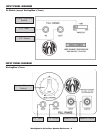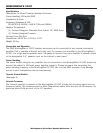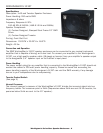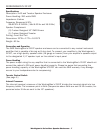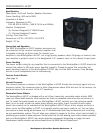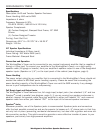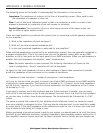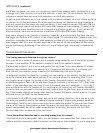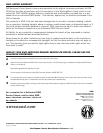
Workingman’s Series Bass Speaker Enclosures • 13
than one cabinet, check all cable connections in the chain. If you then suspect that the problem
may be a bad cable, you can use a 9 volt battery as a cable-tester. To do so, plug one end of the
questionable cable into your speaker cabinet, and then touch the phone plug on the other end to
the two terminals (+ and –) of the battery, contacting the tip and sleeve. When you connect the
battery to the phone plug, a good cable will will pass the voltage to the speakers, which will be
indicated by both an audible noise and the physical reaction of your speakers—the cones will
move out. Disconnect the battery, and the cones will move back in. (Reverse the battery, and the
speakers will move in when connected.) If you don’t hear anything and your speakers don’t move,
then the cable is faulty and should be repaired or replaced.
You can test for an intermittent cable by keeping the battery on the phone plug while swinging
the wire like a jump rope. If the cable is good, the speaker will remain in its battery activated
position and not make any noise. This test can be especially handy after making new cables or
repairing old ones, and it can also be used to check speaker phasing.
Note: Holding a battery on a phone plug continuously will drain the battery quickly, so don’t
overdo it. Conversely, this test will tell you if you have a dead 9 volt battery; if you know
the cable is good but the speakers don’t move, toss the battery.)
Before reconnecting your system and turning the amplifier on, make one last check to be sure all
of your cables are connected properly—especially your speaker cables. If a loose speaker cable is
plugged in while you’re playing, it could cause your AC or speaker fuse to blow. For this reason we
recommended keeping several spare fuses on hand.
“I hear a tinny/hollow/lifeless sound.”
“The sound has no ‘body’ to it.”
“It just sounds bad.”
This could be because your enclosures are out of phase. Basically, this means that while the
speaker cones of one cabinet are moving out, the cones of the second cabinet are moving in. The
net result is that little or no sound is produced. To verify this situation, you can use a 9 volt bat-
tery. Turn off your amplifier and unplug the speaker cable from the amp, leaving the other end still
connected to the enclosure. Touch the plus (+) side of the battery to the tip of the phone plug and
the minus (–) side of the battery to the sleeve of the phone plug. When you do this, the cone(s) in
the cabinet should move outward. When the battery is disconnected, the cone(s) will go back to
their original position. Next, repeat the procedure with the second enclosure; chances are the
cone(s) will move in the opposite direction (inward). If this is the case, the speakers are wired out
of phase.
Take your battery and recheck the phasing of both speakers, using your speaker cable. If they
check out okay, then your speaker cable is miswired—that is, plus and minus have been reversed.
You will need to purchase a replacement speaker cable or have the cable rewired.
Note: Whenever you replace a speaker or have one replaced, use this test to make sure it
has been properly installed in the enclosure. You should also check all new or repaired
cables the same way.







